Tom's Hardware Verdict
The Microsoft Surface Laptop Go is a pretty, lightweight device with a premium feel, but the hardware inside doesn’t match what you can get for the price elsewhere.
Pros
- +
Attractive, mostly aluminum design
- +
Small and lightweight
- +
Comfortable keyboard
- +
Little bloatware
Cons
- -
Sub-1080p resolution
- -
Middling battery life
- -
No fingerprint reader on base model
- -
Very poor specs on base models
Why you can trust Tom's Hardware
If you’re like me, you’ve been working (or learning) at home since March. And for many, that has meant that a computer like one of the best ultrabooks has become an increasingly important tool. In that regard, the Microsoft Surface Laptop Go ($549.99 to start; $899.99 as tested) is here at a good time. People need affordable devices, and being the lightest Surface Laptop ever doesn’t hurt.
Microsoft made some sacrifice to get to that $549.99 price. It cut biometrics (there is a fingerprint reader on more expensive configurations) and the machine’s partially plastic with a lower resolution screen. There’s also a last gen Intel Core i5-1035G1 CPU across the lineup. But with premium construction, it could still win some people over in the budget department.
However, the Surface Laptop Go also scales up to $899.99, and when you get there, some of those cuts seriously stop making sense.
Design of the Surface Laptop Go
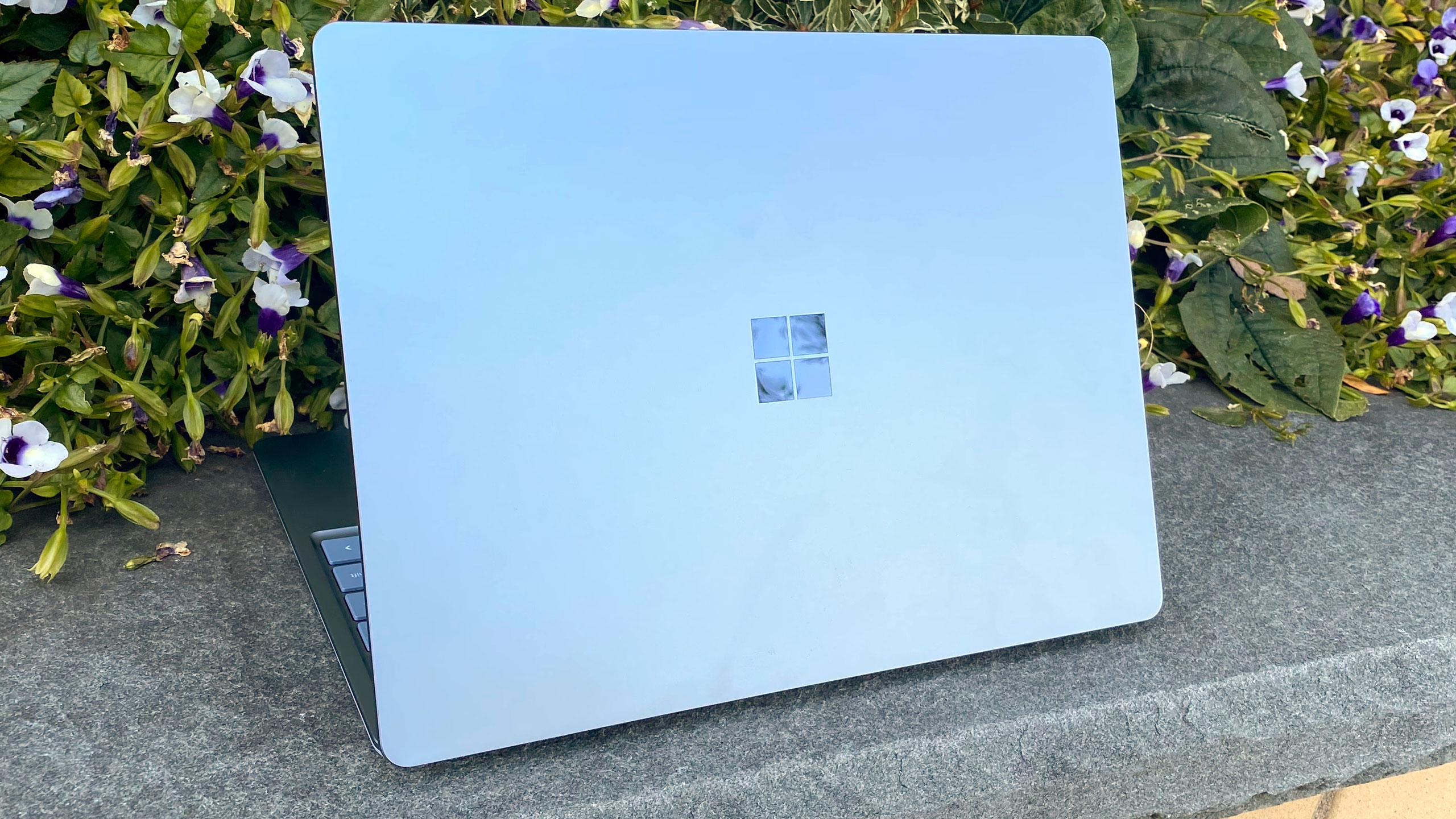
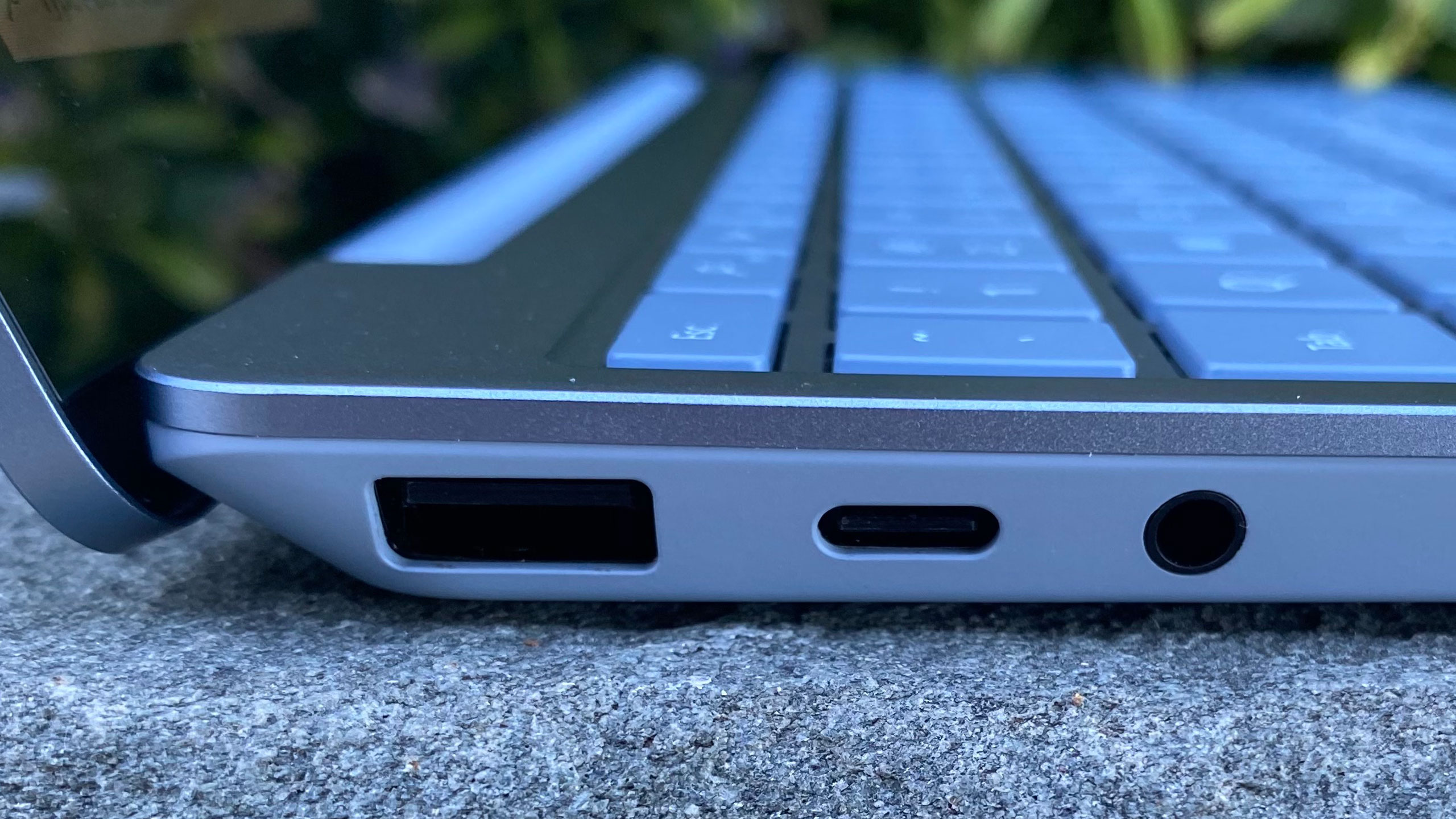
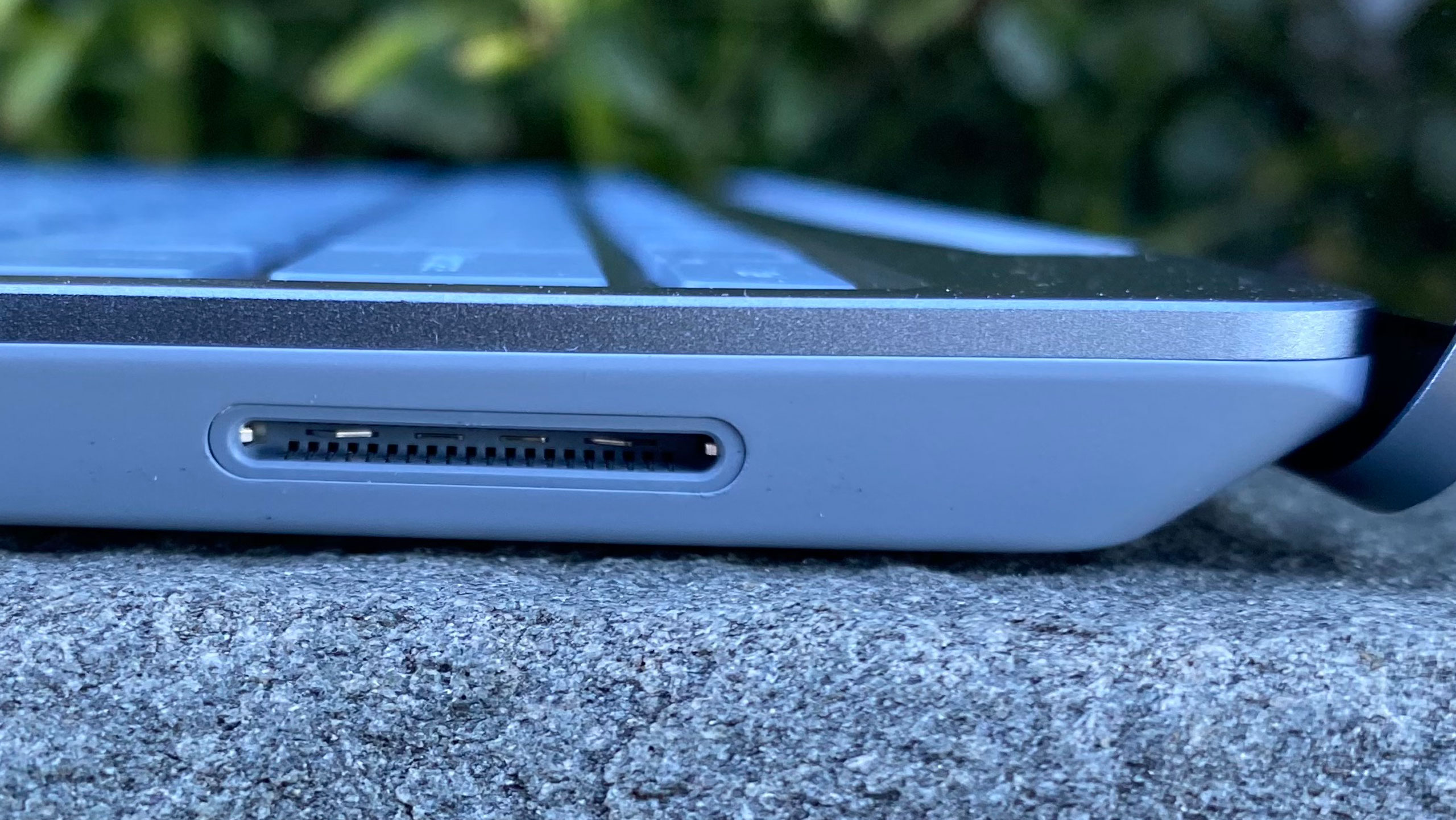
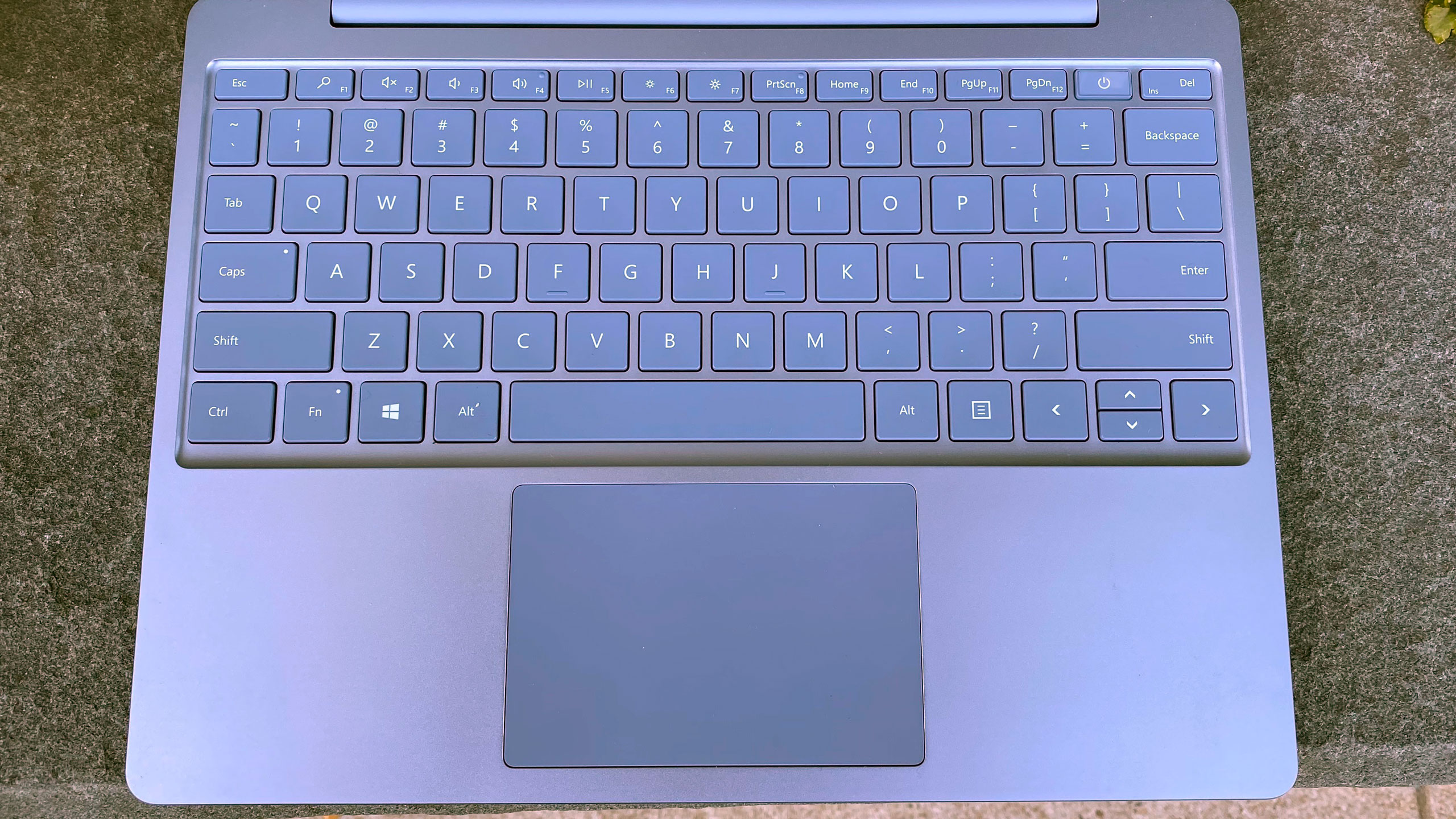


I was enamored with the Surface Laptop Go from the first glance. It truly is a smaller Surface Laptop, and that’s fine with me. Our review unit came in “ice blue,” a grayish blue that provides just a hint of whimsy. The lid is made of aluminum and entirely plain except for curved edges and a reflective Microsoft logo.
There are a few small changes once you unfold the machine. The 12.45-inch display has curved edges, just like bezels, which is new for the Surface lineup. Those edges are thin, except on the bottom.
You won’t find a Windows Hello IR camera for facial recognition log-ins alongside the regular webcam here. Instead, you can login with your fingerprint via a sensor inside the power button. A ring around the power button lights up when the computer is locked to indicate where to place your finger once you’ve set up Windows Hello.
Unlike the lid, the keyboard deck is also made of aluminum, but the bottom of the laptop is made of plastic. It has a mylar touchpad, rather than glass, and the keyboard isn’t backlit. These aren’t necessarily deal killers, just the types of sacrifices you make to get to a $549 starting price.
The left side of the laptop is where you’ll find most of the ports: USB Type-A and USB Type-C, as well as a 3.5 mm headphone jack. On the right there is only the proprietary Surface Connect port, which you use with the charger. I would’ve much preferred to see Microsoft put another USB Type-C port here for charging, but the company shows no signs of getting rid of it.
At just 2.5 pounds and 11 x 8.1 x 0.6 inches, the Surface Laptop Go is plenty portable, whether you’re carrying it from room to room or actually taking it to work or school in person. Of course, it’s not as light as the Surface Go 2, a tablet (1.2 pounds, 9.7 x 6.9 x 0.3 inches), but the MacBook Air (2.8 pounds, 12 x 8.4 x 0.6 inches) and Acer Swift 3 (2.7 pounds, 12.7 x 8.6 x 0.6 inches) are both larger and slightly heavier with 14-inch and 13-inch screens, respectively.
Microsoft Surface Laptop Go Specifications
| CPU | Intel Core i5-1035G1 |
|---|---|
| Graphics | Intel UHD Graphics |
| RAM | 8GB LPDDR4X-3733 MHz |
| SSD | 256GB PCIe NVMe SSD |
| Display | 12.4 inch, 1536 x 1024, 3:2 Touch display |
| Networking | Wi-Fi 6 (802.11ax), Bluetooth 5.0 |
| Ports | USB Type-C, USB Type-A, 3.5 mm headphone jack, Surface Connect port |
| Camera | 720p webcam |
| Battery | 39.7 Wh |
| Power Adapter | 39 W |
| Operating System | Windows 10 Home in S Mode (Tested with Windows 10 Home) |
| Dimensions | 11 x 8.1 x 0.6 inches /278.2 mm x 206.2 mm x 15.7 mm |
| Weight | 2.5 pounds |
| Price (as Configured) | $899.99 |
Productivity Performance
The Surface Laptop Go is powered by an Intel Core i5-1035G1, no matter which configuration you choose. Our review unit paired that with 8GB of RAM and a 256GB SSD.
Get Tom's Hardware's best news and in-depth reviews, straight to your inbox.
For our productivity tests, we’re comparing it to Microsoft’s other latest Go product, the Surface Laptop Go 2, released earlier this year with an older Intel Core m3-8100Y, the Acer Swift 3 with AMD’s Ryzen 7 4700U, and the Apple MacBook Air, with another 10th Gen Intel processor, the Core i5-1030NG7.
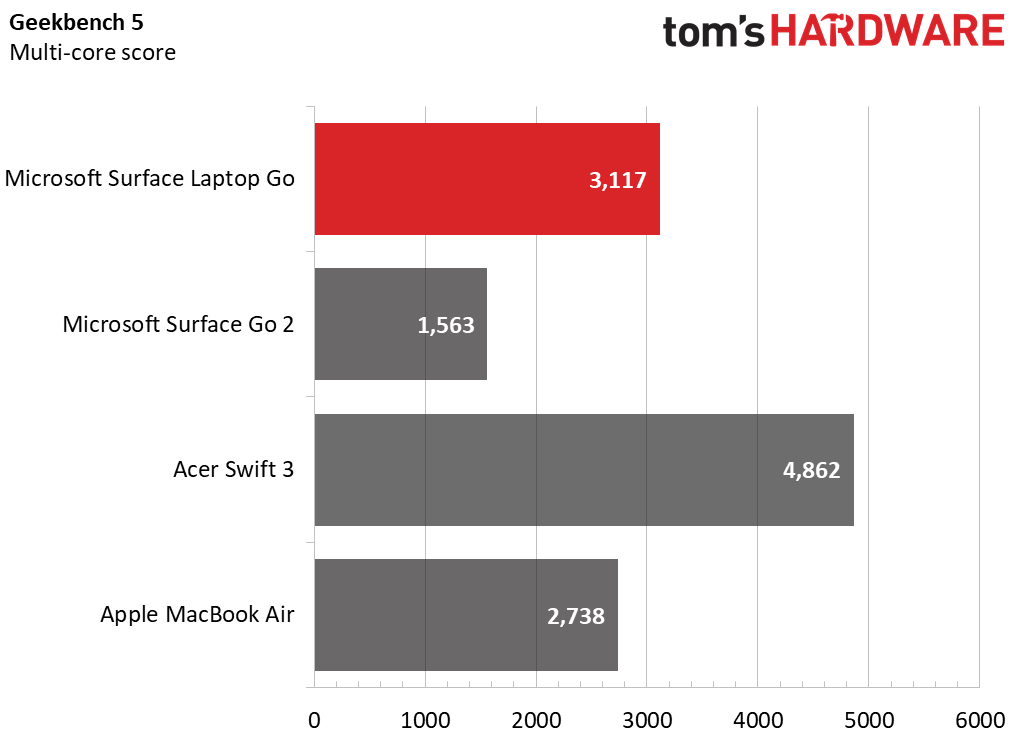


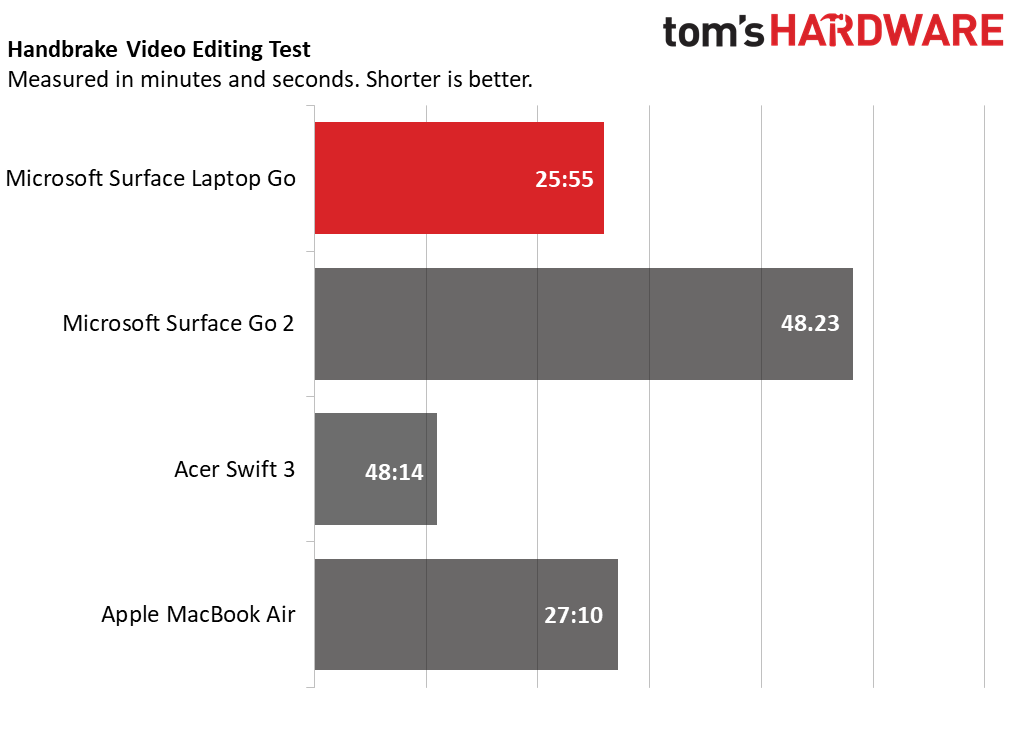
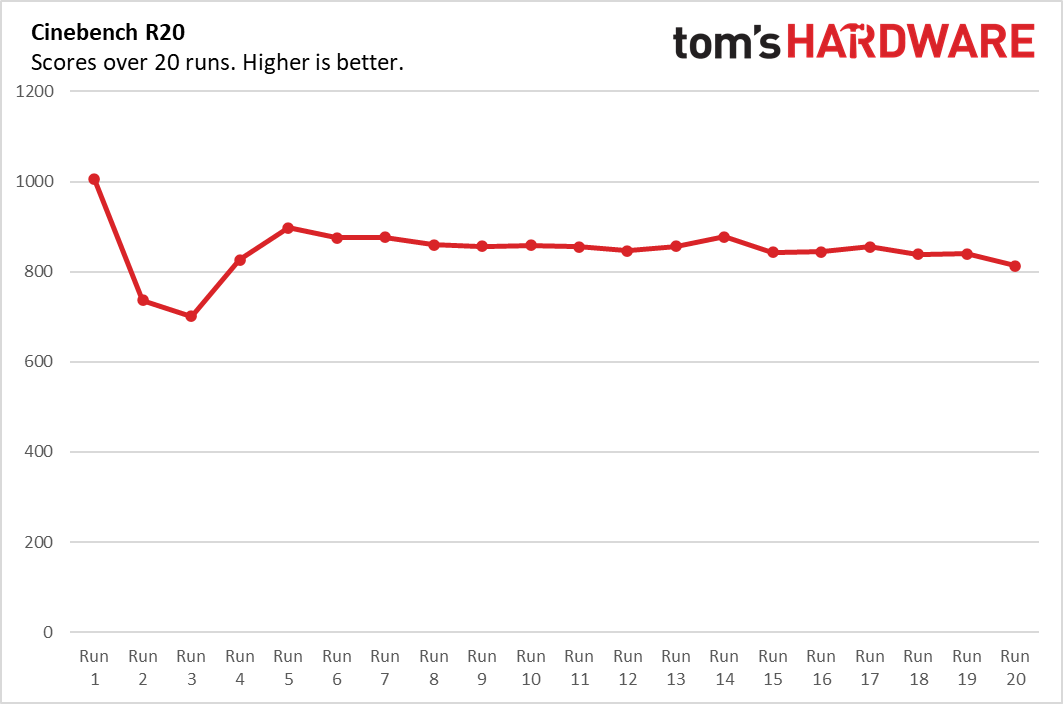
On Geekbench 5.0, the Surface Laptop Go notched a multi-core score of 3,117. The fact that it beat the Surface Go 2 (1,563), with its older processor meant for fanless designs wasn’t surprising. The Swift 3 with Ryzen 7 did better (4,862), but the MacBook Air fared worse (2,738).
Microsoft’s petite laptop transferred 5GB of files at a rate of 278.4 MBps. That’s faster than the Surface Go 2 (181.8 MBps) but far slower than both the Swift (462.7 MBps) and MacBook Air (508.9 MBps).
It took 25 minutes and 55 seconds for the Surface Laptop Go to transcode a 4K resolution video to 1080p resolution with Handbrake. That’s a bit faster than the MacBook Air (27:10) and far faster than the Surface Go 2 (48:14).
As a stress test, we run Cinebench R20 30 times on a loop and check for heat and stability. The Surface Laptop Go had an expected drop after its first run of 1,005.2, down into the 700’s. By run 4, the CPU had stabilized in the mid 800s.
During the Cinebench test, the CPU hit an average clock speed of just under 1.5 GHz and an average temperature of 66.7 degrees Celsius (152.1 degrees Fahrenheit).
While the Intel Core i5-1035G1 is built on Intel’s 10th Gen “Ice Lake” architecture, it doesn’t get the graphics benefits that the higher-end chips offer. Instead, it uses Intel UHD graphics. The Surface Laptop Go 2 earned a score of 1,229 on 3DMark Fire Strike. While that beat the Surface Go 2, the Acer Swift 3, with AMD’s most recent Radeon graphics, was far better (2,848).
Display on the Surface Laptop Go
The 12.45-inch display is likely to be the most controversial aspect of the device. It’s a touchscreen in the 3:2 aspect ratio, just like all of the other Surfaces before it. But this screen has a resolution of 1536 x 1024. On this small diagonal, that’s 148 pixels per inch (PPI).
It’s definitely usable. When I watched the trailer for Wonder Woman 1984, it got bright enough, and while colors weren’t amazing, the heroine’s red and blue outfit still stood out among the white walls enduring a battle against the Cheetah. The 3:2 aspect ratio is good for seeing more of your work, thanks to the extra height. But when you get close at this low resolution? Yeah, you can make out some pixels.
While something sub-1080p is, (unfortunately), still considered acceptable on budget machines, this system goes up to $900. And that display doesn’t change. If Surface is supposed to be leading on Windows, I wish Microsoft would have gone with a 1080p equivalent to show other companies what can and should be done.
The Surface Laptop Go’s screen covers 76.8% of the sRGB color gamut, in line with the Surface Go 2 (76.1%). close to the MacBook Air (80%) and way better than the Acer Swift 3 (44.2%).

Microsoft’s panel measured an average of 319.4 nits of max brightness. That’s better than the Swift 3 (251 nits) but below the MacBook Air (386 nits) and Surface Go 2 (408 nits).
Keyboard and Touchpad on the Surface Laptop Go

One continuous strength on the Surface Laptop line (and its sibling, the Surface Book), has been its keyboards. That is still the case on the Surface Laptop Go. It’s big omission is that the keyboard isn’t backlit.
It feels a tad less clicky than the keys on its more expensive cousins, but ultimately there is still a tactile feel, even if it’s slightly more bouncy. I hit 110 words per minute on the 10fastfingers.com typing test with my usual error rate.
The 3.9 x 2.6-inch touchpad is a decent size considering how small the laptop is. It’s mylar, not glass, but still feels smooth to the touch, just with slightly more friction. Of course, it has Windows Precision drivers, and I didn’t have any issues with navigation or gestures.
Audio on the Microsoft Surface Laptop Go
When I listened to The Ataris’ “The Boys of Summer,” the music was plenty loud but kind of flat. The vocals and guitars were clear enough, but the drumline wasn’t particularly powerful, and I could barely make out the bass at all. That type of performance is pretty average for a budget machine, but this configuration is out of budget territory.
For uses that don’t have that level of audio detail, like video conferencing, the Surface Laptop Go is fine, though that’s where I’m most likely to use headphones anyway.
Upgradeability of the Microsoft Surface Laptop Go
Unlike Microsoft’s more recent efforts in the Surface Laptop 3 and Surface Pro X, the Surface Laptop Go isn’t user upgradeable. There are no exposed screws on the bottom of the chassis. Be sure to get a configuration that will last you in the long term (see the Configurations section below).
Battery Life on the Microsoft Surface Laptop Go
The Surface Laptop Go may be incredibly portable, but you’ll need to top it off if you’re using it for long periods of time. On our battery test, which continuously browses the web, streams video and runs OpenGL tests all over Wi-Fi with the screen at 150 nits brightness, it ran for just 7 hours and 42 minutes. Good thing the charger is small, too.

The Surface Go 2 lasted the longest out of the comparison group, at 11:38, while the AMD Ryzen-based Acer Swift 3 ran for 11:09. The Apple MacBook Air also offered more endurance at 9:31.
Heat on the Microsoft Surface Laptop Go
We took skin temperatures while running our Cinebench R20 loop (see th ePerformance section above) to test the laptop under a heavy load. The laptop fans definitely whirred throughout (with a bit of an occasional whistle), but the laptop wasn’t untouchably hot.

The center of the keyboard, between the G and H keys, measured 43.8 degrees Celsius (110.8 Fahrenheit). This wasn’t exactly comfortable but not usable either. The touchpad was cooler, hitting 32 degrees Celsius (89.6 degrees Fahrenheit).

The hottest spot was on the bottom of the laptop, by the hinge. It reached 49.5 degrees Celsius (121.1 degrees Fahrenheit). Could I stand this heat on my lap? Yes. Would I prefer it on a desk? Also yes.
Webcam on the Microsoft Surface Laptop Go
Microsoft put a 720p resolution webcam in the bezel above the Surface Laptop Go’s display. Like the majority of laptop webcams out there, it’s not very special. In a still from my desk, there was some graininess. The colors were accurate – my bright red shirt was just the right shade – and there was more detail than in some other webcams, but it’s nothing amazing.
But it's more disappointing to see this on the Surface Laptop Go than on other laptops because with the Surface Go 2, released earlier this year, Microsoft used a 5 megapixel front-facing camera that was capable of video chatting at 1080p. Right now, where so many people are working or studying from home, I wish that carried over to the Surface Laptop Go.
Software and Warranty on the Surface Laptop Go
Perhaps one of the best, albeit lesser hyped, parts of the Surface line is just how little included software there is.
The big app that comes with it is Microsoft’s Surface software, a place to check your Surface serial number, drivers and warranty coverage and connect accessories. There are also trails of the Office 365 suite.
Otherwise, the bloat only consists of what you would get on any Windows 10 machine, including Hulu, Spotify, Facebook Messenger and Hidden City: Hidden Object Adventure.
The laptop comes in Windows 10 Home in S Mode, which Microsoft claims is more secure and keeps the laptop fast. This, however, limits you to software from the Microsoft Store. If you’re only using a web browser and software in that store, you may be OK. But to test it, we needed to make the free change to regular Windows 10 Home, which lets you install anything you want.
Microsoft sells the Surface Laptop Go with a 1-year warranty.
Configurations of the Microsoft Surface Laptop Go
We tested the top-end, $899.99 configuration of the Surface Laptop Go, with an Intel Core i5-1035G1 CPU, 8GB of RAM and a 256GB SSD. This version also includes Microsoft’s One Touch fingerprint reader in the power button.
You can get our model with 16GB of RAM, but you have to buy it through Microsoft’s business program. That costs $1,199.99.
The base model is $549.99, and while it has the same processor, it offers just 4GB of RAM and 64GB of slower eMMC storage. This version also doesn’t include the fingerprint reader. It’s hard to recommend this model unless you prefer the Surface aesthetic above all else.
In the middle, there’s a $699.99 option with the same chip and 8GB of RAM but just 128GB of SSD storage. This configuration also has a fingerprint reader.
Bottom Line

The Surface Laptop Go fills a huge need in Microsoft’s hardware lineup, providing a somewhat affordable entry into the company’s ecosystem and showcase for Windows 10. Right now, as so many people work and learn from home, the standard laptop form factor is more useful than ever, so that fills a need.
Microsoft’s $549.99 starting point may attract many who want something that looks and feels premium. Some cuts, like the backlit keyboard and IR camera and use of a partially plastic chassis, aren’t big deals. But a sub-1080p display (or in this 3:2 case sub-1920 x 1280), feels cheap, especially for Surface, especially in 2020.
The Core i5 Ice Lake chip in there, while not the latest, will give people with largely browser-based workloads enough headroom. But 4GB of RAM doesn’t really cut it beyond a few browser tabs, and just 64GB of eMMC storage isn’t an enticing proposition, which could effectively force a jump up to the mid-range $699.99 configuration with 8GB of memory and a real SSD, albeit it a 128GB one.
Which brings me to hesitations I had about my $899.99 review unit. It has the sacrifices expected of a $549.99 laptop, especially when it comes to display resolution and storage space.
Perhaps the best comparison is the Acer Swift 3. It’s $649, which is $100 more than the Surface Laptop Go, and I understand that’s a lot. But you also get a 1080p screen (albeit a lackluster one), a much more powerful AMD Ryzen 7 4700U, far more battery life and a larger 512GB SSD.
Part of what you’re paying for with the Surface Laptop Go is the premium name and feel. How much is that worth to you? If you opt for the low-end specs, it’s questionable. At the high end, it isn’t really worth it, as you’re getting into entry-level Surface Laptop 3 territory.
One other suggestion: the Surface Go 2. If you need small, that tablet starts at $549.99 with less power and the same lackluster RAM and storage, though it has dropped in price so that you can get it, as of this writing, with an M3, 8GB of RAM and 128GB for the same cost on Amazon. You’ll have to pay more for the keyboard, of course, but you’ll also get a 1920 x 1280 display, 1080p webcam and facial recognition.
The Surface Laptop Go is built with purpose, but at this price it has a ton of competition from the greater Windows 10 ecosystem, not to mention premium Chromebooks. The 3:2 screen here is rare, and so is the premium construction. Some will rightfully want this. But as you get higher up the configuration stack, you can find better deals. While I was generally happy while using the Surface Laptop Go, if I were to actually buy a new laptop, I know I could get more.

Andrew E. Freedman is a senior editor at Tom's Hardware focusing on laptops, desktops and gaming. He also keeps up with the latest news. A lover of all things gaming and tech, his previous work has shown up in Tom's Guide, Laptop Mag, Kotaku, PCMag and Complex, among others. Follow him on Threads @FreedmanAE and BlueSky @andrewfreedman.net. You can send him tips on Signal: andrewfreedman.01
-
Arbie ReplyIt took 25 minutes and 55 seconds for the Surface Laptop Go to transcode a 4K resolution video to 1080p resolution with Handbrake. That’s a bit faster than the MacBook Air (27:10) and far faster than the Surface Go 2 (48:14).
What about the Swift 3 with the Ryzen CPU?